Which of the following sequences correctly represents the flow of electrons during photosynthesis?
A. H2O > NADPH > Calvin Cycle
B. NADPH > Chlorophyll > Calvin Cycle
C. NADPH > Electron transport chain > O2
D. NADPH > O2 > CO2
E. H20 > Photosystem 1 > Photosystem 2
A. H2O > NADPH > Calvin cycle
Photosynthesis is a redox reaction. This means that H2O is _____ during the light reactions and CO2 is _____ during the Calvin cycle.
A. Oxidized ... Reduced
B. Reduced ... Reduced
C. Consumed ... Consumed
D. Consumed ... Reduced
E. Reduced ... Oxidized
A. Oxidized ... Reduced
What is the basic role of CO2 in photosynthesis?
A. CO2 is fixed or incorporated into organic molecules.
B. CO2 is taken in by plants as a form of inverse respiration, in which carbon dioxide is “breathed in” and oxygen is “breathed out.”
C. CO2 is a source of electrons in the formation of organic molecules.
A. CO2 is fixed or incorporated into organic molecules.
Which of the following is a product of the light reactions of photosynthesis?
A. Glyceraldehyde-3-phosphate
B. High-energy photons
C. Oxygen, ATP, and NADPH
D. NADP+ and RuBP
E. Water and CO2
C. Oxygen, ATP, and NADPH
Photosystem 1
Photosystem 2
Photosystem 1 & 2
Reduction of NADP+
Reduction of primary electron acceptor
Oxidation of electron transport chain between two photosystems
Reduction of electron transport chain between the two photosystems
Light absorption
Oxidation of water
Photosystem 1
Oxidization of water
Reduction of electron transport chain between the two photosystems
P2
Reduction of NADP+
Oxidation of electron transport chain between two photosystems
P1&2
Reduction of primary electron acceptor
Light absorption
Electron transport step l Energy input required
- Water > P680+
- P680 > Pq (plastoquinone)
- Pq > P700+
- P700 > Fd (ferredoxin)
- Fd > NADP+
Electron transport step l Energy input required
- Water > P680+ … no energy
- P680 > Pq (plastoquinone) … energy
- Pq > P700+ … no energy
- P700 > Fd (ferredoxin) ... energy
- Fd > NADP+ … no energy
Diagram of H+ movement
- P. –
- P.Site of H+ release
- P. Site of ATP synthesis
- B. H+ pumped across membrane
- B. –
- B. H+ diffuses across membrane
When light strikes chlorophyll molecules, they lose electrons, which are ultimately replaced by _____.
A. Oxidizing glucose
B. Fixing carbon
C. Splitting water
D. Breaking down ATP
E. Removing them from NADPH
C. Splitting water
C4 plants occur more commonly in desert conditions because _____.
A. They store carbon by incorporating CO2 into organic acids that are later catabolized
B. They produce water as a product of their photosynthetic pathways
C. The stomata open at night and close in the day
D. They can fix carbon at the lower CO2 concentrations that develop when the stomata are closed
E. They produce carbon dioxide internally via photorespiration
D. They can fix carbon at the lower CO2 concentrations that develop when the stomata are closed
Carbon fixation involves the addition of carbon dioxide to _____.
A. Rubisco
B. G3P
C. NADPH
D. RuBP
E. 3-PGA
D. RuBP
After 3-PGA is phosphorylated, it is reduced by _____.
A. CO2
B. NADPH
C. ATP
D. ADP
E. NADP+
B. NADPH
How many carbon dioxide molecules must be added to RuBP to make a single molecule of glucose?
A. 6
B. 2
C. 10
D. 4
E. 8
A. 6
In the Calvin cycle, how many ATP molecules are required to regenerate RuBP from five G3P molecules?
A. 1
B. 3
C. 2
D. 4
E. 5
B. 3
Which term describes ATP production resulting from the capture of light energy by chlorophyll?
A. Substrate-level phosphorylation
B. Photophosphorylation
C. Dephosphorylation
D. Oxidative phosphorylation
B. Photophosphorylation
True or false? The chemiosmotic hypothesis states that the synthesis of ATP generates a proton gradient that leads to electron flow through an electron transport chain.
True
False
False
According to the chemiosmotic hypothesis, what provides the energy that directly drives ATP synthesis?
A. Temperature gradient
B. Osmotic gradient
C. Electrons
D. Proton gradient
D. Proton gradient
Which of the following particles can pass through the ATP synthase channel?
A. ATP
B. ADP
C. Inorganic phosphate
D. Protons
D. Protons
True or false? The region of ATP synthase that catalyzes the production of ATP from ADP and inorganic phosphate spans the chloroplast membrane.
True
False
False
Chloroplast membrane vesicles are equilibrated in a simple solution of pH 5. The solution is then adjusted to pH 8. Which of the following conclusions can be drawn from these experimental conditions?
A. ATP will be produced because the proton gradient favors proton movement through the ATP synthase channels.
B. ATP will not be produced because there is no ADP and inorganic phosphate in the solution.
C. The change in the solution's pH results in a gradient across the chloroplast membranes such that there is a lower concentration of protons inside the vesicles and a higher concentration outside.
D. Protons will not diffuse toward the outside of the vesicles.
B. ATP will not be produced because there is no ADP and inorganic phosphate in the solution.
_____ has a longer wavelength than _____.
A. Yellow ... red
B. Red ... green
C. Violet ... blue
D. Green ... yellow
E. Blue ... green
B. Red ... green
The overall function of the Calvin cycle is _____.
A. Making sugar
B. Producing carbon dioxide
C. Capturing sunlight
D. Splitting water
E. Oxidizing glucose
A. Making sugar
In mechanism, photophosphorylation is most similar to
A. Reduction of NADP+.
B. Carbon fixation.
C. The Calvin cycle.
D. Oxidative phosphorylation in cellular respiration.
E. Substrate-level phosphorylation in glycolysis.
D. Oxidative phosphorylation in cellular respiration.
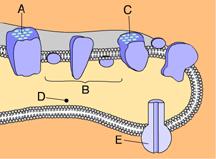
Which of these phosphorylates ADP to make ATP?
a. A
b. D
c. E
d. C
e. B
C. E
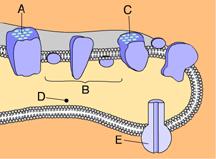
_____ releases energy that is used to pump hydrogen ions from the stroma into the thylakoid compartment.
A. E
B. C
C. B
D. D
E. A
C. B
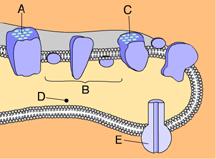
_____ splits water into 1/2 O2, H+, and e- .
A. B
B. C
C. A
D. E
E. D
C. A
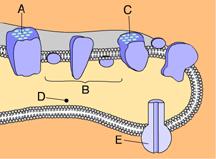
Energized electrons from ____ enter an electron transport chain and are then used to reduce NADP+.
A. B
B. E
C. A
D. C
E. D
D. C
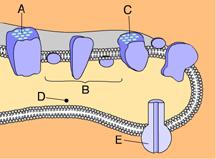
Chlorophyll can be found in _____.
A. B and C
B. A and C
C. A and B
D. B and D
E. B and E
B. A and C
Which of these equations best summarizes photosynthesis?
A. C6H12O6 + 6 O2 → 6 CO2 + 12 H2O
B. H2O → 2 H+ + 1/2 O2 + 2e-
C. 6 CO2 + 6 H2O → C6H12O6 + 6 O2
D. 6 CO2 + 6 O2 → C6H12O6 + 6 H2O
E. C6H12O6 + 6 O2 → 6 CO2 + 6 H2O + Energy
C. 6 CO2 + 6 H2O → C6H12O6 + 6 O2
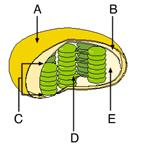
Where does the Calvin cycle occur?
A. C
B. E
C. D
D. B
E. A
B. E
The light reactions of photosynthesis use _____ and produce _____.
A. Water ... NADPH
B. NADPH ... oxygen
C. Carbon dioxide ... oxygen
D. NADPH ... NADP+
E. Carbon dioxide ... sugar
A. Water ... NADPH
Select the correct molecule that is the main product of the Calvin cycle.
A. G3P
B. NADPH
C. Glucose
A. G3P
In C3 plants the conservation of water promotes _____.
A. A shift to C4 photosynthesis
B. The light reactions
C. The opening of stomata
D. Photosynthesis
E. Photorespiration
E. Photorespiration
In C4 and CAM plants carbon dioxide is fixed in the _____ of mesophyll cells.
A. Grana
B. Thylakoids
C. Cytoplasm
D. Stomata
E. Stroma
C. Cytoplasm
C4 plants differ from C3 and CAM plants in that C4 plants _____.
A. Use malic acid to transfer carbon dioxide to the Calvin cycle
B. Transfer fixed carbon dioxide to cells in which the Calvin cycle occurs
C. Are better adapted to wet conditions
D. Open their stomata only at night
E. Use PEP carboxylase to fix carbon dioxide
B. Transfer fixed carbon dioxide to cells in which the Calvin cycle occurs
How is photosynthesis similar in C4 plants and CAM plants?
A. In both cases, rubisco is not used to fix carbon initially.
B. Both types of plants make sugar without the Calvin cycle.
C. In both cases, only photosystem I is used.
D. Both types of plants make most of their sugar in the dark.
E. In both cases, thylakoids are not involved in photosynthesis.
A. In both cases, rubisco is not used to fix carbon initially.